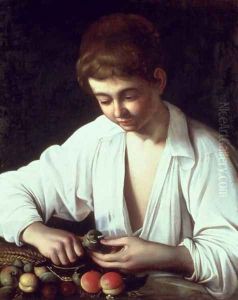Studio of Caravaggio, Michelangelo Paintings
Michelangelo Merisi da Caravaggio, known simply as Caravaggio, was a profoundly influential Italian painter whose works fundamentally shifted the course of European art. Born in 1571 in Milan, Caravaggio moved to Rome in his early twenties, where he began his career as a painter. His early work showed the influence of the Mannerist style, which was prevalent at the time, but he soon developed a starkly realistic approach that emphasized chiaroscuro, a technique that uses strong contrasts between light and dark to achieve a sense of volume in modelling three-dimensional objects and figures.
Caravaggio's paintings are known for their dramatic, sometimes violent depictions of religious and mythological subjects, rendered with a remarkable attention to the details of human emotion and physicality. His style was characterized by the use of ordinary people as models, including prostitutes and the poor, for religious figures, a practice that was groundbreaking and controversial. He painted directly from life, without the extensive preparation that was typical of his contemporaries, and his approach to composition was innovative and often involved extreme foreshortening and unconventional perspectives.
His most notable works include 'The Calling of Saint Matthew', 'Judith Beheading Holofernes', 'The Supper at Emmaus', and 'The Conversion of Saint Paul', among others. Caravaggio's influence was immediate and profound, leading to the development of the Baroque style of painting. His use of light and shadow was particularly influential and was emulated by his followers, known as the Caravaggisti.
Caravaggio's life was tumultuous and marred by brawls, legal troubles, and a notorious temper. In 1606, he killed a man in a duel and fled Rome, spending time in Naples, Malta, and Sicily. During these years, his work became increasingly dark and introspective. Caravaggio died in 1610 under mysterious circumstances while on his way back to Rome, possibly from lead poisoning from his paints or from a fever contracted after a shipwreck.
The 'Studio of Caravaggio' refers to the circle of artists who were influenced by Caravaggio's revolutionary painting style. These artists often imitated his technique of dramatic lighting and realistic depiction of subjects. Some of them may have been actual pupils or assistants in his workshop, but Caravaggio is not known to have run a large studio in the manner of other artists of the time. The legacy of his work was carried on by artists throughout Europe, who absorbed and adapted his techniques to their own national and individual styles.
